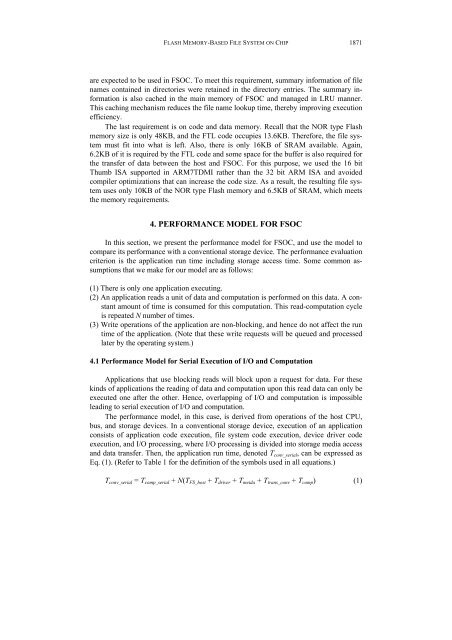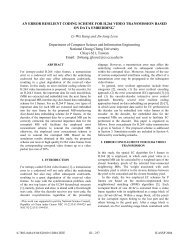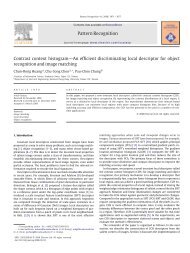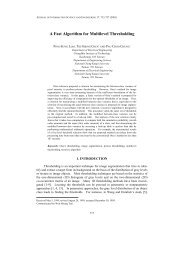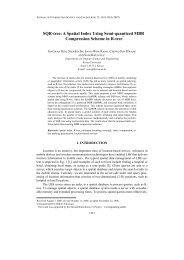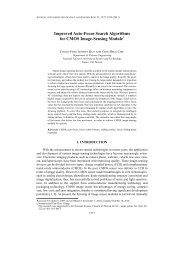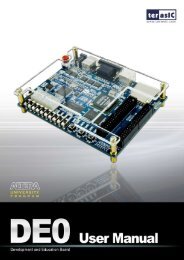Design, Implementation, and Performance Evaluation of Flash ...
Design, Implementation, and Performance Evaluation of Flash ...
Design, Implementation, and Performance Evaluation of Flash ...
Create successful ePaper yourself
Turn your PDF publications into a flip-book with our unique Google optimized e-Paper software.
FLASH MEMORY-BASED FILE SYSTEM ON CHIP<br />
are expected to be used in FSOC. To meet this requirement, summary information <strong>of</strong> file<br />
names contained in directories were retained in the directory entries. The summary information<br />
is also cached in the main memory <strong>of</strong> FSOC <strong>and</strong> managed in LRU manner.<br />
This caching mechanism reduces the file name lookup time, thereby improving execution<br />
efficiency.<br />
The last requirement is on code <strong>and</strong> data memory. Recall that the NOR type <strong>Flash</strong><br />
memory size is only 48KB, <strong>and</strong> the FTL code occupies 13.6KB. Therefore, the file system<br />
must fit into what is left. Also, there is only 16KB <strong>of</strong> SRAM available. Again,<br />
6.2KB <strong>of</strong> it is required by the FTL code <strong>and</strong> some space for the buffer is also required for<br />
the transfer <strong>of</strong> data between the host <strong>and</strong> FSOC. For this purpose, we used the 16 bit<br />
Thumb ISA supported in ARM7TDMI rather than the 32 bit ARM ISA <strong>and</strong> avoided<br />
compiler optimizations that can increase the code size. As a result, the resulting file system<br />
uses only 10KB <strong>of</strong> the NOR type <strong>Flash</strong> memory <strong>and</strong> 6.5KB <strong>of</strong> SRAM, which meets<br />
the memory requirements.<br />
4. PERFORMANCE MODEL FOR FSOC<br />
In this section, we present the performance model for FSOC, <strong>and</strong> use the model to<br />
compare its performance with a conventional storage device. The performance evaluation<br />
criterion is the application run time including storage access time. Some common assumptions<br />
that we make for our model are as follows:<br />
(1) There is only one application executing.<br />
(2) An application reads a unit <strong>of</strong> data <strong>and</strong> computation is performed on this data. A constant<br />
amount <strong>of</strong> time is consumed for this computation. This read-computation cycle<br />
is repeated N number <strong>of</strong> times.<br />
(3) Write operations <strong>of</strong> the application are non-blocking, <strong>and</strong> hence do not affect the run<br />
time <strong>of</strong> the application. (Note that these write requests will be queued <strong>and</strong> processed<br />
later by the operating system.)<br />
4.1 <strong>Performance</strong> Model for Serial Execution <strong>of</strong> I/O <strong>and</strong> Computation<br />
Applications that use blocking reads will block upon a request for data. For these<br />
kinds <strong>of</strong> applications the reading <strong>of</strong> data <strong>and</strong> computation upon this read data can only be<br />
executed one after the other. Hence, overlapping <strong>of</strong> I/O <strong>and</strong> computation is impossible<br />
leading to serial execution <strong>of</strong> I/O <strong>and</strong> computation.<br />
The performance model, in this case, is derived from operations <strong>of</strong> the host CPU,<br />
bus, <strong>and</strong> storage devices. In a conventional storage device, execution <strong>of</strong> an application<br />
consists <strong>of</strong> application code execution, file system code execution, device driver code<br />
execution, <strong>and</strong> I/O processing, where I/O processing is divided into storage media access<br />
<strong>and</strong> data transfer. Then, the application run time, denoted Tconv_serial, can be expressed as<br />
Eq. (1). (Refer to Table 1 for the definition <strong>of</strong> the symbols used in all equations.)<br />
Tconv_serial = Tcomp_serial + N(TFS_host + Tdriver + Tmeida + Ttrans_conv + Tcomp) (1)<br />
1871


